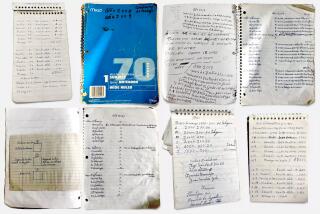Cultural Exchange: Mexico’s UNAM aims to put it all online
Reporting from Mexico City — — It is one of Latin America’s best-known and biggest schools, with five times more students than UCLA and a treasured spot in Mexican life as the people’s house of higher learning.
But to prove it really matters, the 100-year-old National Autonomous University of Mexico, or UNAM, is placing its work on the Internet.
All of it.
In an effort of staggering scope, UNAM hopes to upload everything it has — from 18th century newspapers and vintage films to hundreds of thousands of student theses and a still-to-be-gauged sea of classroom teaching items — and let the world have it free of charge. The project, called Toda la UNAM en Línea (All of UNAM Online), made its debut last month with an interactive website (www.unamenlinea.unam.mx) following a year of planning and preparation.
The effort provides Web access to the university’s vast collections of photographs, old radio recordings and documentary films; mountains of legal opinions; and catalogs of thousands of species of plants and animals native to Mexico and more. Still in its early stages, the portal is meant one day to put the university’s abundant resources within reach of anyone with an Internet connection, in Mexico and abroad.
More than 200 universities around the world have posted classroom materials online during the last decade as part of an open-access trend in higher education. The Massachusetts Institute of Technology, for example, estimates it has reached more than 100 million people worldwide through a 9-year-old program called OpenCourseWare, with material from 2,080 of its courses.
But UNAM’s longer-term plans extend far beyond providing lecture notes and classroom handouts by giving users digital access to libraries, special collections, conferences and the research of students and professors that previously was often buried from view.
“We’re making this remarkable effort so that the products and resources of the university can reach the most Mexicans possible,” said Imanol Ordorika, a university official who came up with the idea for Toda la UNAM en Línea and is helping coordinate its development. “Anybody can see the quality of teaching or research, the diversity of topics.” The project’s coordinators are seeking the equivalent of about $15 million to carry out the ongoing work next year.
In part, UNAM officials also hope to quiet critics. The university, long a hotbed of leftist protest, has been assailed for failing to provide a full enough accounting of what the school accomplishes with its $2.1-billion budget, most of which comes from the federal government.
The chorus grew especially loud last year after the rector, Jose Narro Robles, made a high-profile appeal for “funding and understanding for higher public education” during a conference attended by President Felipe Calderon. Narro has frequently criticized Calderon’s policies, including the government’s 5-year-old war on drug cartels.
Sen. Gustavo Madero, a member of Calderon’s conservative party, said it was time for the UNAM to show what it does with its money, which he said included half of Mexico’s research funds. “What is needed is to show results … to be accountable,” Madero said at the time.
The online project is, in part, a response to that. “All of a sudden we said, ‘We should flood them with everything the UNAM does — put it all on the Internet,’” Ordorika said. “What better accountability could there be than all the books we do, all the articles we do, all the services the university provides, all the libraries, all the theses? Everything.”
While many UNAM divisions were already converting material to digital form, the online project has quickened the pace and raised sticky questions, such as who owns a thesis — the university or student? (For now, the school says the student does.)
It has also dramatically increased the school’s online presence, now up to some 3 million Web pages and with the second-highest number of visits of any Mexican site, after El Universal newspaper. The online effort also means coding material to make it easier to find via search engines like Google.
Teachers and students outside UNAM might use its culture podcast (www.descargacultura.unam.mx/app1#inicioAPP1) to hear late poet Jaime Sabines reading his work or sift through the half-million entries in the UNAM’s vast biological collection (unibio.unam.mx) to learn about scorpions in central Mexico or cactuses in the south. Armchair physicists can download the syllabus for a graduate-level class in quantum mechanics.
Surf the UNAM-housed national periodicals archive, with newspapers going back to 1722, and a few clicks offer a first-blush take on Mexico’s history. One newspaper account in 1919, for example, compared Emiliano Zapata, now a revered hero of the Mexican revolution, unflatteringly to “the king of the Huns that sacked Rome.”
Though only 1 in 5 of its households has Internet access, Mexico is fast embracing the digital age. It remains to be seen whether UNAM’s online push tilts the political debate over university accountability, but it may offer a way for the school to reassert its long-held status as part of the foundation of Mexican society, officials say.
“With this,” Ordorika said, “we are affirming that yes, the university belongs to the people.”
More to Read
The biggest entertainment stories
Get our big stories about Hollywood, film, television, music, arts, culture and more right in your inbox as soon as they publish.
You may occasionally receive promotional content from the Los Angeles Times.










